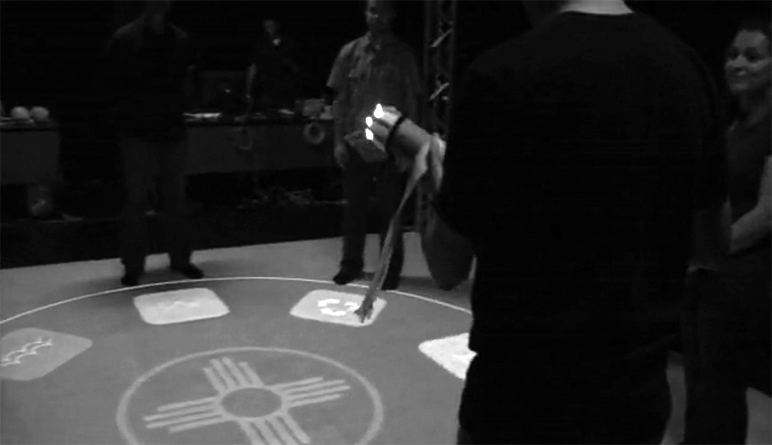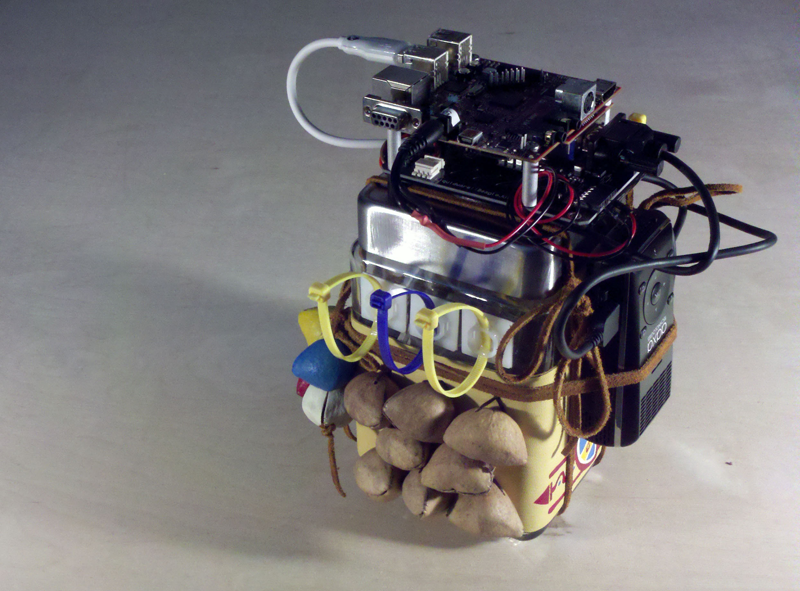

![]()
Tecno-Sovereignty — 2010-2014
The work featured on this page is a set of indigenous media systems that are grounded by theories of media and indigenous knowledge systems. The cultural practices and experiential media systems featured on this page are designed to mediate social gatherings for embodied learning, which can take place in formal and/or informal learning environments. This work is inspired by rhetorical spaces and literacy practices such as Paulo Friere's Circulos de Cultura, Native American Talking Circles, Northern New Mexican Resolanas, and storytelling traditions. The following works are examples of indigenous intercultural collaborations, where diverse peoples claim their digital commons for the exercise of self-determination.
Click here to learn more about Indigenous Tecno-Sovereignty.
Resolana Electronica
A Resolana Electronica is a place and process by which a group of people gather to have a dialogue with each other regarding a predetermined topic. In a Resolana Electronica, participants gather in a circle to deliver oratories that are augmented with shared images and sounds. Throughout the dialogues, a given orator uses symbolic gestures while using a ceremonial tool such as a rattle or stick to call and manipulate media in ways that are meaningful to the story she/he is telling. The images and sounds shared during a Resolana Electronica are uploaded by the participants themselves. Throughout the gathering, the system keeps track of how images are used in order to calculate an image map that provides resolaneras/os with information that can be used to consider new directions for the dialogue that have not yet emerged.
Resolana Electronica has been used to accomplish social and cultural work in formal and informal learning settings. In formal learning it has supported high school and college course curriculums that include community dialogues in cultural studies and language-learning classes. In both contexts, the Resolana Electronica focused on student topics of concern such as immigration, aspirations, change, and violence. Through these efforts it provided students with a cultural practice for thinking critically about local community issues while learning digital literacy skills such as media creation and the use of digital media as a method for communication (= encoding + decoding + comprehension + production + consumption + distribution), it also provided these students with a forum by which they had the opportunity to practice literacy and rhetorical oratory skills in a local public setting. As an indigenous expression of the digital age, the Resolana Electronica is a tool by which elders teach students to think critically about the use of digital media, while illustrating the relevance of ancestral knowledge in connection with digital literacy and self-determination.

Photos Above and Below: A group of gatherers having a dialogue during a resolana.

Martinez, C., et. al. (2010). Culturally Sensible Place-Making: Design of the Mediated XicanIndio Resolana, Proceedings of the ACM MIT TEI ’10 Conference. Cambridge, MA.
Digital Ayoyote Rattle
The Digital Ayoyote Rattle is an effort to prototype a portable and affordable Resolana Electronica. This prototype demonstrates a rattle containing all of the technology to facilitate a digitally augmented resolana. The following is an image of this prototype.

Martinez, C. (2011). Digital Ayoyote Rattle: The Design of a Portable Low-Cost Digital Media System for a Mediated XicanIndio Resolana, Proceedings of the IKTC '11 Indigenous Knowledge Technology Conference. Windhoek, Namibia.
Interactive Mexican Calendar
This is a prototype for culturally responsive elementary school mathematics for students. This Chicanx interactive mural is comprised of a series of scenes designed to teach mathematics while students utilize, study, and experience the Aztec calendar system. This is a learning tool designed for teaching mathematical ratios, periodicity, and number theory. The goal of this design is to meet the epistemological and ontological requirements for culturally responsive learning specific to Chicanx living in the United States. This also offers students of all backgrounds the opportunity to partake in Mexican indigenous cultural experiences for embodied learning. These experiences include resolanas, mariachi music, indigenous vocabulary, history, astronomy, storytelling, observations, and Aztec cosmology. The intention behind this design is to couple indigenous mathematics with standard math curricula for elementary education. This system features digital media learning that affords face-to-face interaction by multiple collocated participants situated in a circle. In an exercise to embody the expression of a given ratio, students have an opportunity to collaborate with each other in scenario 4 to physically express a given ratio between two spinning wheels.
GameBot: Stickball
Stick Ball is the Native American game that Lacrosse derives from. This GameBot version of Stickball is officiated by an interactive robot, and is designed by indigenous artists to encourage discourse around the meaning and cultural implications of technology in the presence of traditions. Stickball was created by Cristóbal Martínez, Randy Kemp, Raven Kemp, Gkisedtanamoogk. Stickball was installed for a limited time at the Arizona Science Center.